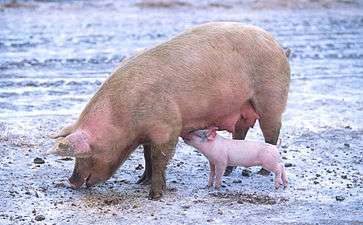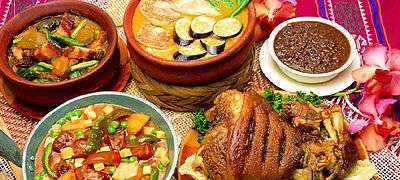Suckling pig
A suckling pig is a piglet fed on its mother's milk (i.e., a piglet which is still a "suckling"). In culinary contexts, a suckling pig is slaughtered between the ages of two and six weeks. It is traditionally cooked whole, often roasted, in various cuisines. It is usually prepared for special occasions and gatherings.
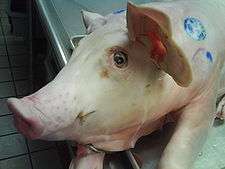
The meat from suckling pig is pale and tender and the cooked skin is crisp and can be used for pork rinds. The texture of the meat can be somewhat gelatinous due to the amount of collagen in a young pig.
History
There are many ancient recipes for suckling pig from Roman and Chinese cuisine. Since the pig is one of the first animals domesticated by human beings for slaughter, many references to pigs are found in human culture. The suckling pig, specifically, appears in early texts such as the sixth-century Salic law. As an example of a law governing the punishment for theft, Title 2, article 1, is, in Latin, Si quis porcellum lactantem furaverit, et ei fuerit adprobatum (malb. chrane calcium hoc est) CXX dinarios qui faciunt solidos III culpabilis iudicetur. "If someone has stolen a suckling pig and this is proven against him, the guilty party will be sentenced to 120 denarii which adds up to three solidi (Latin coins)." The words "chrane calcium" are written in Frankish; "calcium" (or "galza" in other manuscripts) is the gloss for "suckling pig"; porcellum lactantem.[1] These glosses in Frankish, the so-called Malbergse Glossen, are considered the earliest attested words in Old Dutch.[2]
Controversy
.jpg)
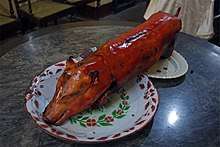
It is often argued that the use of pigs for human consumption is unethical,[3][4] especially in the case of young animals removed from their mothers earlier than weaning would happen in nature:[5] natural weaning takes place at around 12 weeks of age, whereas suckling pigs are slaughtered at 2 to 6 weeks of age. Further, investigations by media and animal rights groups have uncovered animal cruelty and inhumane conditions related to the farming of suckling pigs.[6][7] Practices such as "thumping," killing piglets by repeatedly swinging them against a concrete wall or floor, are commonplace on hog farms supplying suckling pig.[8] The sows, mother pigs, are in many countries kept in gestation crates or farrowing crates, which render them nearly immobile and unable to interact with their newborn offspring.[4]
Pigs are regarded to be highly intelligent social animals.[9][10] Animal rights groups like PETA argue[11] that this makes their exploitation and suffering in the hands of the factory farming industry especially unethical.
Regional dishes
There are various preparations for suckling pig in Western and Asian cuisines. The most popular preparation can be found in northern Spain, namely Segovia.
Spanish-speaking countries
| Wikibooks Cookbook has a recipe/module on |
Lechón is a pork dish in several regions of the world, most specifically Spain and its former colonial possessions. The word lechón originated from the Spanish term leche (milk), alluding to the immaturity of the piglet. Lechón is a popular item in the cuisine in Los Angeles, Spain, Cuba, Puerto Rico, Honduras, Argentina, Uruguay, Bolivia, Ecuador, Perú, Costa Rica, the Dominican Republic, and other Spanish-speaking nations in Latin America. In Spanish cuisine, cochinillo asado is commonly used to refer to roast piglet, as lechón has drifted linguistically to mean any roasted pig. In most of these regions, lechón is prepared throughout the year for special occasions, during festivals, and the Thanksgiving.
After seasoning, the piglet is cooked by skewering the entire animal, entrails removed, on a large stick and cooking it in a pit filled with charcoal. The piglet is placed over the charcoal, and the stick or rod it is attached to is turned in a rotisserie action.
Asia
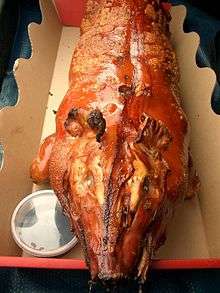
In Asia, roast suckling pig is eaten in Chinese or Vietnamese restaurants for important parties.[12] It is also a popular dish at wedding dinners or a party for a baby's completion of its first month of life.[13][14]
In the former Spanish colony of the Philippines, lechón (Filipino: litsón) is considered a national dish. As the usage of the term has evolved over the years, "lechón" has now come to refer to roasted pig in general (including suckling pigs). Suckling pigs in the country are referred to as lechón de leche, which corresponds to the term cochinillo in Spain.
There is also variant of suckling pig among the Indonesian non-Muslim ethnic groups, such as the Balinese, Batak, and Minahasa. Some pork dishes are also influenced by ethnic Chinese.
European
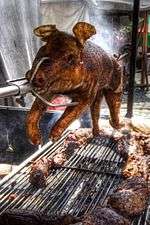
The European cuisines of Romania, Portugal (leitão), Spain, Germany, Austria, Albania, Croatia, Slovenia, Serbia, Macedonia [15] and Georgia[16] favor it highly as well. It also accompanies goose as the traditional Christmas feast of families in Russia and Serbia. Russian Navy maintains a tradition of presenting a roast piglet (or several) to the crew of a ship returning from deployment.
Suckling pig is known in German and Austrian cuisine as Spanferkel. It can be roasted in the oven[17] or grilled, and is often served at festive occasions such as Oktoberfest.[18]
In Sweden suckling pig is called spädgris, it is usually cooked in the oven, or sometimes roasted directly over the fire. It is often stuffed with various fruits such as apples and plums, together with butter and breadcrumbs.[19]
United States
The suckling pig is used in Cajun cuisine in the southern U.S., where the Cochon de Lait festival is held annually in the small town of Mansura, Louisiana. During this festival, as its name implies, suckling pigs are roasted. Other uses for the suckling pig in the U.S. include slow roasting in an oven or (as in a Hawaiian-style pig roast) in a pit. The latter remains popular in the cuisine of the Southern United States.
References
- Gorlé, Frits; John Gilissen (1989). Historische inleiding tot het recht, Volume 1. Kluwer. p. 166. ISBN 978-90-6321-654-2.
- Ruth Schmidt-Wiegand, "Die Malbergischen Glossen, eine frühe Überlieferung germanischer Rechtsprache," in Beck, Heinrich (1989). Germanische Rest- und Trümmersprachen; Volume 3 of Ergänzungsbände zum Reallexikon der germanischen Altertumskunde. Walter de Gruyter. ISBN 978-3-11-011948-0.
- "Pigs". Animal Welfare Institute.
- "Raise Pigs Right - Enviornment". World Animal Protection USA.
- "Animal Facts - Pigs". www.veganpeace.com.
- Sommerlad, Nick (7 March 2016). "Cruelty of pork revealed as dead pigs rot while others suffer terrible injuries". mirror.
- "Pig Farrowing Crates: A "comfy" place, or a lifetime of confinement?". 11 September 2018.
- Solomon, Ari; Communications, ContributorDirector of; Animals, Mercy For (26 December 2012). "This Little Piggy Got Slammed Against Concrete". HuffPost.
- Angier, Natalie (9 November 2009). "In Pig Cognition Studies, Reflections on Parallels With Humans" – via NYTimes.com.
- "Pigs Are Intelligent, Emotional, and Cognitively Complex". Psychology Today.
- "Pigs: Intelligent Animals Suffering on Farms and in Slaughterhouses". PETA. 1 March 2004.
- "飲宴6招 色食肥 (Chinese)". eastweek. 6 October 2012. Retrieved 28 October 2012.
- "久享盛名的四更烤乳豬 (Chinese)". travel.sina.com.hk. 9 September 2009. Retrieved 28 October 2012.
- "Siu Mei Kung Fu". rthk.hk. 6 October 2012. Retrieved 28 October 2012.
- Langenfeld, Annemarie (20 September 2009). "Spanferkel und Pizzen heiß begehrt". Der Westen. Retrieved 8 October 2009.
- Dadiani, Niko. "Gochi (Roast Suckling Pig)". About Georgia. Retrieved 8 October 2009.
- Scheibler, Sophie Wilhelmine (1866). Allgemeines deutsches kochbuch für alle stände, oder gründliche anweisung alle arten speisen und backwerke auf die wohlfeilste und schmackhafteste art zuzubereiten: Ein unentbehrliches handbuch für angehende hausmütter, haushälterinnen und köchinnen. C.F. Amelang. pp. 157–58.
- Dittrich, Michael (7 October 2009). "Oktoberfest mit Spanferkel". Stimberg Zeitung (in German). Archived from the original on 19 July 2011. Retrieved 8 October 2009.
- Östman, Elisabeth (1911). Iduns kokbok. Isaac Marcus Boktryckeriaktiebolag. pp. 286–287.
External links
| Wikispecies has information related to Sus |
| Wikimedia Commons has media related to Suckling pig. |
